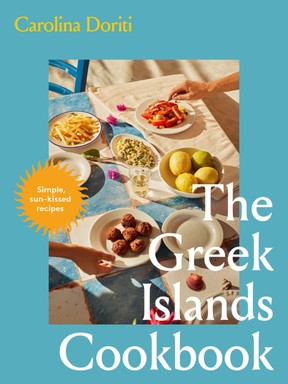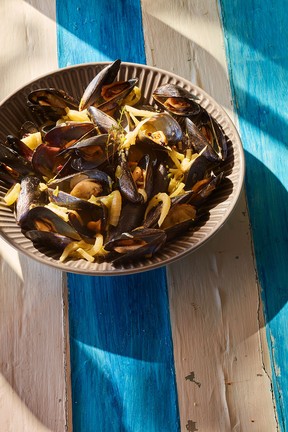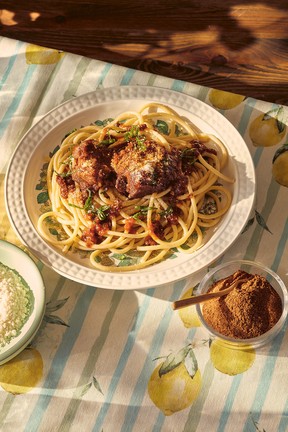Cook This: 3 recipes from The Greek Islands Cookbook, including a spicy beef stew
Carolina Doriti showcases the diverse influences and rich food cultures of the Greek islands

Article content
Our cookbook of the week is The Greek Islands Cookbook by Athens-based chef and food historian Carolina Doriti.
Jump to the recipes: eggs with sausages, potatoes and mint (fourtalia), steamed mussels with ouzo and fennel, and beef stewed in a spicy tomato sauce served over pasta (pastitsada).
I’ll never forget my first trip to the Greek islands 25 years ago. It was the dead of winter, and Santorini was blissfully quiet. My friend Aliki and I spent our days admiring the blue-domed churches with only stray cats and dogs for company.
Reading Athens-based chef and food historian Carolina Doriti’s second title, The Greek Islands Cookbook (Murdoch Books, 2025), brought memories rushing back and taught me about places I’d never heard of.
“You got the chance to experience the real Santorini,” says Doriti, laughing. “I’m so glad you got to see it back then, because now, it’s still very beautiful, but it’s just full of hotels, full of swimming pools.”
Doriti has been visiting the Greek islands her whole life. For the follow-up to her cookbook debut, Salt of the Earth (Quadrille, 2023), she gives readers a true slice of island life. “I wanted to make a book with real recipes that are made on the islands.”
She shares her love of the region with essays on the essential aspects of the cuisine — such as honeys and island cheeses — sun-drenched photography by her close friend Manos Chatzikonstanti, and roughly 90 recipes representative of as many islands as possible.
“I hope it inspires people to discover those islands beyond the resort. Beyond whatever they read somewhere, to really explore them. And know a few things before they go, what to look for.”
Doriti’s grandfather, George, was from the Cycladic island of Paros, and his stories captured her imagination at a young age. As a food writer and culinary producer, Doriti has travelled extensively throughout the islands. She tapped into her memories and turned to her notebooks, which she never leaves home without.

Like Santorini, islands such as Mykonos and Corfu are hugely popular with tourists. Yet, with more than 6,000 islands and islets, roughly 227 of them inhabited, there are many others to explore.
“Some of the most beautiful islands, and the ones where I used to spend all my summer holidays since I was really young, like Paros, they’ve become completely different places now,” says Doriti. “But there are still places. I think the most important thing is for the locals to protect their places.”
In the introduction, Doriti explains the distinct geographical clusters — the Ionian Islands, the Cyclades, the North-Eastern Aegean Islands, the Dodecanese Islands, Crete, the Saronic Islands, Evia and the Sporades Islands — each with a different energy, influences and microclimates.
Even as someone who was born and raised in Athens and has visited most of the Greek islands, Doriti is as enthusiastic as ever to learn about their local traditions. Not even Greeks are aware of some of the specialties of the islands, Doriti highlights, such as the use of saffron that defines the baking on Astypalea, on the westernmost point of the Dodecanese. “They’re small cultures, really, and it’s great to discover them.”
Doriti is driven to preserve the traditions of the islands and go beyond the clichés. For instance, the average tourist visits expecting to find lamb souvlaki, which doesn’t exist. The most popular version of the quintessential Greek street food is made with pork on the islands (chicken is the second favourite). Feeding on stinging nettles or acorns, pigs and goats are better suited to the dry, rugged terrain than sheep, which require grass to graze on. Some islands lacked olive oil, but had plenty of lard.
“The cuisine is extremely rich. It’s beyond the Greek salad and the moussaka and the souvlaki,” says Doriti. “Everybody loves it, but there’s so much more to show, and I’m excited to show it and share it.”
EGGS WITH SAUSAGES, POTATOES AND MINT

Fourtalia
Serves: 2-4
3 medium potatoes (such as Maris Piper, Russet, Yukon Gold or any other variety good for frying), peeled
2 thick rustic sausages (about 180 g/6 oz, spicy ones work well, too)
Olive oil or any other neutral oil, for frying
6 large free-range eggs
2 tbsp chopped fresh mint leaves, plus extra to serve
Salt and freshly ground black pepper
To serve (optional):
Crumbled feta
Step 1
Cut the potatoes into rough 1.5-cm (1/2-inch) cubes. Place them in a bowl of cold water with a pinch of salt and let them soak for 15 minutes. Drain in a colander and pat dry with paper towels.
Step 2
Meanwhile, slice the sausages into 1-cm (1/3-inch) -thick rounds. Heat a large, deep, non-stick frying pan (skillet) with a lid over a medium heat and drizzle in a little oil. Once hot, add the sliced sausages and cook for a few minutes, turning occasionally, until lightly browned on all sides. Leaving any oil behind in the pan, transfer the sausages to a plate and keep warm.
Step 3
Using the same pan, add enough oil to reach a depth of 3 cm (1 inch) to cover the potatoes. Turn up the heat to medium-high. Once the oil reaches 180C (350F), add the diced potatoes and fry until crisp and golden — this typically takes 8-12 minutes depending on the variety of potato. For the first 6-7 minutes, avoid stirring the potatoes to allow them to cook evenly. Once they start to crisp up, gently stir to ensure even cooking.
Step 4
While the potatoes are frying, crack the eggs into a bowl, add the mint and season with plenty of salt and black pepper. Lightly beat until just combined.
Step 5
Once the potatoes are crispy, carefully ladle or pour off some of the oil (about 1/3 cup) from the pan. Return the pan to a medium-low heat. Arrange the cooked sausages over the potatoes in the pan and pour over the beaten eggs. Cover with the lid and cook for 6 minutes, or until the eggs are set.
Step 6
Using a spatula, transfer the fourtalia to a serving platter. Sprinkle over the crumbled feta, if using, immediately before serving.
STEAMED MUSSELS WITH OUZO AND FENNEL

Midia ahnista me ouzo
Serves: 4
1 kg (2 lb 4 oz) fresh live mussels
60 g (2 oz) butter
1 fennel bulb, trimmed, halved and thinly sliced (reserve any fronds to serve)
4-5 spring onions (scallions), thinly sliced
3-4 garlic cloves, peeled and thinly sliced
2 bay leaves
100 mL (3 1/2 fl oz) ouzo
3-4 small thyme sprigs
Zest of 1 small lemon
3-4 tbsp chopped parsley
Freshly ground black pepper
Step 1
Wash the mussels to remove any dirt or grit. If any mussels are open, tap them on the counter — if they close, they are alive; if they remain open, discard them.
Step 2
Place a large, shallow pot or deep pan with a well-fitting lid over a medium heat. Add half the butter to the pot and, once hot, add the sliced fennel bulb, spring onions, garlic and bay leaves. Cook until the vegetables start to soften.
Step 3
Pour the ouzo into the pot and add the remaining butter. When everything starts to simmer, add the mussels and thyme sprigs. Immediately cover the pot and let the mussels simmer for 2 minutes. Without removing the lid, shake the pot to move the mussels around. Let them cook for a further 1 minute before repeating this process (the total cooking time should be about 6 minutes).
Step 4
Take off the lid and mix the mussels well in the cooking liquid in the pan. Check to make sure that all the mussels have opened. Discard any unopened mussels. Add the lemon zest, parsley and plenty of black pepper, then cover the pot and shake again.
Step 5
Transfer the mussels to a deep serving platter and spoon over the sauce along with the cooked fennel and spring onions. Scatter over any roughly chopped fennel fronds, if using. Serve the mussels with warm hunks of toasted bread.
BEEF STEWED IN A SPICY TOMATO SAUCE SERVED OVER PASTA

Pastitsada
Serves: 4-6
For the spetseriko spice mix:
10 bay leaves
1/2 tbsp chili flakes
1 tsp fennel seeds
1/2 tsp cumin seeds
2 tbsp sweet paprika
1/2 tbsp spicy paprika
1/2 tbsp ground cinnamon
1/2 tsp ground nutmeg
1/2 tsp ground cloves
1/2 tsp freshly ground black pepper
1/2 tsp ground allspice
For the stew:
1 kg (2 lb 4oz) beef for stewing, cut into small portions about 70-100g (2 1/2-3 1/2 oz) each
60 mL (2 fl oz) olive oil
2 large onions, peeled and finely chopped
3 garlic cloves, peeled and minced
3 bay leaves
1 tsp spetseriko spice mix
1 tsp tomato paste
20 mL (4 tsp) red wine vinegar
120 mL (4 1/2 fl oz) sweet red wine, such as Mavrodaphne
1 thin sliver orange zest
1 small basil sprig, plus extra chopped to serve (optional)
250 mL (9 fl oz) tomato pulp or passata (strained tomatoes)
250 mL (9 fl oz) hot vegetable or meat stock or water
Salt and freshly ground black pepper
For the pasta:
500 g (1 lb 2oz) bucatini (or any other pasta)
1-2 tbsp olive oil
Grated Kefalotiri, pecorino or Parmesan
Step 1
First, make the spetseriko. Warm a clean, dry pan over a medium heat. Add the bay leaves, chili flakes, fennel seeds and cumin to the pan and toss for 1-1 1/2 minutes until lightly toasted and fragrant. Tip the toasted spices into a mortar and pestle or spice grinder and crush them to a fine powder. Mix in the ground spices and store in a sealed jar for up to 6 months.
Step 2
Season the beef with salt and pepper and let it sit at room temperature for 30 minutes before cooking.
Step 3
Place a large shallow pot over a medium-high heat. Add 3 tablespoons of the olive oil and, once hot, brown the meat on all sides. Using a slotted spoon, transfer the meat to a platter.
Step 4
In the same pot, add another tablespoon of olive oil and sauté the onions with a bit of salt until they turn light golden. Add in the garlic, bay leaves and the spetseriko spice mix, stirring briefly. A few seconds later, add the tomato paste and stir gently. Return the browned meat to the pot, pour in the vinegar, and after a minute, pour in the wine. Allow the alcohol to evaporate for a couple of minutes, then pour in the tomato pulp and hot broth, and add in the orange zest and basil sprig. Reduce the heat to low, cover with a lid, and gently simmer for 50-60 minutes or until the meat is very tender and the sauce has thickened. Remove and discard the bay leaves, basil sprig and orange zest.
Step 5
Cook the pasta according to the packet instructions. Drain and return the pasta to the pan, then add in a splash of olive oil and toss to coat.
Step 6
Serve the beef with the sauce on top of the pasta, then sprinkle with some grated cheese and extra ground black pepper. If you like, scatter over a handful of chopped basil.
Recipes and images excerpted from The Greek Islands Cookbook by Carolina Doriti, photography by Manos Chatzikonstantis. Reproduced by permission of Murdoch Books.
Our website is the place for the latest breaking news, exclusive scoops, longreads and provocative commentary. Please bookmark nationalpost.com and sign up for our cookbook and recipe newsletter, Cook This, here.














Postmedia is committed to maintaining a lively but civil forum for discussion. Please keep comments relevant and respectful. Comments may take up to an hour to appear on the site. You will receive an email if there is a reply to your comment, an update to a thread you follow or if a user you follow comments. Visit our Community Guidelines for more information.